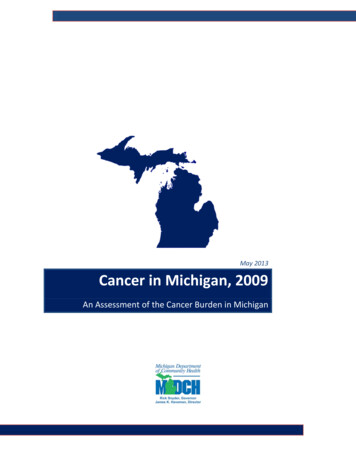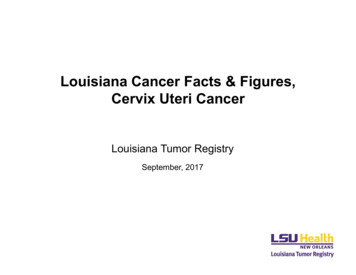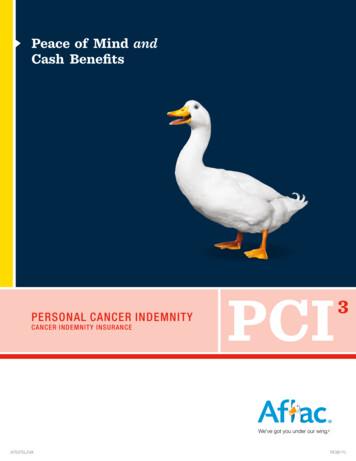
Transcription
May 2013Cancer in Michigan, 2009An Assessment of the Cancer Burden in Michigan
State Of MichiganRick Snyder, GovernorMichigan Department of Community HealthJames K. Haveman, DirectorPublic Health AdministrationMelanie Brim, Senior Deputy DirectorAuthored in PartnershipMichigan Cancer Surveillance Program (MCSP)Division for Vital Records and Health StatisticsGlenn Copeland, DirectorCancer Prevention and Control Program (CPCS)Division of Chronic Disease and Injury ControlPatricia Brookover, DirectorAuthorsGlenn Copeland, MBA (MCSP)Paulette Valliere, PhD (CPCS)Polly Hager, MSN, RN (CPCS)Georgia Spivak, BS (MCSP)Registry Administration (MCSP)Glenn Copeland, MBADonna GeneiTerry McTaggart, BSWon Silva, MAGraphics and Text ProcessingA special thank you to Sandie Richardson (CPCS)Data Processing and Survey (MCSP)Wendy StinnettElaine SnyderMary StephensField Staff (MCSP)Jetty Alverson, CTR, AAClaudia Hardin, CTRDoug Koster, AAS, RHITBrenda Bowen, MS, RHIA, CCS, CCS-P
Table of ContentsI.Overview .1II.Cancers (All Sites) .4III.Female Cancers of the Breast .7IV.Cancers of the Lung and Bronchus .10V.Cancers of the Prostate Gland .14VI.Invasive Cancers of the Colon and Rectum .18VII.Invasive Cancers of the Uterine Cervix .22VIII.Definitions and Technical Notes .26IX.Cancer Incidence, Mortality and Survival Tables.30A. Cancers (All Sites) .54B. Female Cancers of the Breast .70C. Cancers of the Lung and Bronchus .78D. Cancers of the Prostate Gland .94E. Invasive Cancers of the Colon and Rectum .104F. Invasive Cancers of the Uterine Cervix .120G. In Situ Cancers of the Uterine Cervix .128H. Cancer Incidence and Mortality by County, Economic DevelopmentCollaborative, and Health Department of Residence .130
OVERVIEWCancer is the second leading cause of death in Michigan, contributing to significant economic and socialcosts. An estimated 55,660 people in Michigan were diagnosed with cancer during 2010 and 20,740were projected to die from cancer. Uninsured patients and those from ethnic minorities are much morelikely to be diagnosed with cancer at a later stage when treatment is more extensive, debilitating, andcostly. And, since cancer is more prevalent among older adults, priority populations continue to beolder, underserved minority populations.The focus of Michigan’s Cancer Programs is to enhance initiatives, capacity, and infrastructure, towardsthe reduction of cancer morbidity, mortality and related health disparities. Quality cancer registry dataare critical and provide the basis for state and local strategic planning and evaluation. To maximizeimpact on population health, priority interventions will continue to target breast, cervical, colorectal,prostate, and lung cancers and related risk factors with new emphasis on policy and system change.The Michigan Department of Community Health (MDCH) is the recognized public health agency for thestate of Michigan and has a long history of implementing successful cancer control programs. Theseprograms include the: Breast and Cervical Cancer Control ProgramComprehensive Cancer Control ProgramWell-Integrated Screening and Evaluation for Woman Across the Nation ProgramColorectal Cancer Early Detection ProgramImplementation of Policy and Environmental Cancer Control InterventionsCancer Surveillance ProgramCancer Genomics ProgramSuccess has been enhanced by numerous collaborative efforts involving internal and external partners.A description of Michigan’s Cancer Programs is included below.Breast and Cervical Cancer Control ProgramSince 1991, MDCH has implemented a statewide Breast and Cervical CancerControl Program (BCCCP) through a multi-year grant from the United StatesCenters for Disease Control and Prevention (CDC). With these funds, lowincome women have access to life-saving breast and cervical cancer screeningservices and following-up care, including cancer treatment, if needed. BCCCPservices are coordinated through 21 local coordinating agencies. Theseagencies have enlisted the cooperation and participation of physicians,hospitals, and other health care organization in their communities to assurethat all necessary follow-up services are provided. Learn more athttp://www.michigan.gov/mdch/0,4612,7-132-2940 2955 2975-13487-,00.html.1
Comprehensive Cancer Control ProgramIn 1998, the Michigan Cancer Consortium (MCC) became a formalized coalitionof external partner organizations that committed to work together to improvestatewide cancer prevention and control. Today the MCC includes 117 diversemember organizations, e.g. large health systems, hospitals, insurers, providergroups, public health, and others representing disparate group. The MCC,supported by MDCH staff, promotes collaborative planning, implementation,and evaluation of coordinated cancer control initiatives. Learn more athttp://www.michigan.gov/mdch/0,4612,7-132-2940 2955 2975-13561-,00.html.WISEWOMAN ProgramThe Well-Integrated Screening and Evaluation for Women Across the Nation(WISEWOMAN) Program is an extension of the BCCCP. Women are only eligiblefor the WISEWOMAN Program if they are first enrolled in the BCCCP. The mainfocus of WISEWOMAN is to help participants understand and make healthylifestyle choices with a focus on nutrition, physical activity and smokingcessation. Leading a healthy lifestyle will help with current chronic disease riskfactors and symptoms. It may also prevent or delay the development of newchronic disease risk factors. The WISEWOMAN Program is administered by 11agencies and its services are available in 29 Michigan counties. Learn more athttp://www.michigan.gov/mdch/0,4612,7-132-2940 2955 2975-269287-,00.html.Colorectal Cancer Early Detection ProgramAs of July 2010, MDCH expanded colorectal cancer screening services through amulti-year grant from the CDC. The Michigan Colorectal Cancer Early DetectionProgram (MCRCEDP) provides free colorectal cancer screening toasymptomatic, low-income, uninsured and underinsured individuals and isadministered by eight agencies. MCRCEDP provides services in 38 counties.MDCH financially supports the MCRCEDP’s administration, screening, andfollow-up of abnormal screening results. Treatment, if needed, is generouslyprovided through collaboration with community partners. Learn more athttp://www.michigan.gov/mdch/0,4612,7-132-2940 2955 2975-269772-,00.html.2
Demonstrating Capacity of Comprehensive Cancer Control Programs to Implement Policy andEnvironmental Cancer Control InitiativesThe MCC, supported by MDCH staff, is working to implement policy andenvironmental changes for primary, secondary and tertiary cancer preventionstrategies through funding from the CDC. The policy interventions are focusedat community, organizational and state levels to: decrease tobacco use; improvephysical activity and nutrition; increase screening rates for breast, cervical andcolorectal cancers; and improve survivorship programming to reduce the risk ofrecurrent or new cancers. Learn more athttp://w3.michigan.gov/mdch/0,4612,7-132-2940 2955 2975-291523-,00.html.Cancer Surveillance ProgramThe Michigan Cancer Surveillance Program is a population-based cancer registryoperated within the MDCH. The registry covers the entire state of Michigan andrequires reporting of all in situ and invasive lesions, excluding only basal andsquamous cell carcinoma of nongenital skin. Michigan has required reporting ofbenign tumors of the brain and central nervous system since 2004. In addition,the Michigan registry also requires the reporting of CIN III and carcinoma in situof the uterine cervix and has continuously collected these data since becominga statewide registry in 1985. Learn more athttp://www.michigan.gov/mdch/0,4612,7-132-2944 5323---,00.html.Cancer Genomics ProgramThe Cancer Genomics Program is located within the Lifecourse Epidemiologyand Genomics Division (LEGenD) in the MDCH Bureau of Disease Control,Prevention and Epidemiology. The MDCH Cancer Genomics Program hasreceived funding from the CDC since 2003 to integrate genomics in publichealth. Current activities funded by the CDC Division of Cancer Prevention andControl focus primarily on individuals diagnosed with breast cancer at youngages, and their relatives. Cancer Genomics Program staff work closely withinternal and external partners to incorporate the use of genomics in publichealth program activities and cancer surveillance systems. The programfacilitates the Michigan Cancer Genetics Alliance, a member organization ofMCC. MDCH Genomics staff also provides leadership for a new internationalconsortium to promote universal screening for Lynch syndrome on all newlydiagnosed colorectal cancers. Learn more athttp://www.michigan.gov/mdch/0,1607,7-132-2942 4911 4916 47257--,00.html.3
Cancer (All Sites)Bottom LineAccording to the American Cancer Society, about 1,638,910 new cancer cases are expected to bediagnosed in 2012. i In 2012, it is estimated that 577,190 individuals of all ages will die of cancer, secondonly to heart disease.Table 1. Burden of Invasive Cancers (All Sites) by Sex—Michigan Residents, 2009-2010*What is the Impact?FemalesMalesTable 1 summarizes the incidenceNumber ofRate perNumber ofRate perand mortality figures for Michigancases100,000cases100,000males and females due to cancer.Incidence25,144422.027,229537.8(2009)Over 52,000 Michigan males andDeaths9,916156.910,703218.5females, including children, were(2010)diagnosed with cancer in 2009.*Age-adjustedSource: Michigan State Cancer RegistryMales had a significantly higherincidence rate of invasive cancer(537.8 cases per 100,000 males) than for females (422 per 100,000 females). Figure 1 shows thatincidence has beendecreasing slightly over thepast 10 years, with an overallincidence rate of 468.9 casesper 100,000 persons. A slightracial difference exists, with ahigher incidence rate, 487.3cases per 100,000 AfricanAmericans in 2009 comparedto 455.0 cases per 100,000 inCaucasians.Figure 2 clearly shows a race and sex difference in cancer incidence in Michigan. African American (426cases/100,000) andCaucasian (414.7cases/100,000) females’incidences rates show verylittle difference. AfricanAmerican males have asignificantly higher incidencerate of 639.1 cases per100,000, 50 percent higherthan that of females of eithersex. Caucasian males have an4
incidence rate of 510.7 cases per 100,000, a bit less than midway between all females and AfricanAmerican males.During 2010, 20,619 males andfemales, including children died frominvasive cancer, a mortality rate of182.5 deaths per 100,000 persons.Overall, as can be seen from Figure 3,mortality rates continue to declinefor both races. However, AfricanAmericans have higher rates thanCaucasians, 215.0 deaths per 100,000compared to 178.3 amongCaucasians.When looking at Figure 4, thesemortality differences by race becomemore delineated when sex is addedas a factor. While mortality shows adecline for each group, the AfricanAmerican males have, by far, thehighest mortality rate, 269.7 deathsper 100,000, almost double that ofthe lowest group, Caucasian females,whose rate is 153 per 100,000.Caucasian males also have a highermortality rate than all females, 212.9 deaths per 100,000, including African American females whosemortality rate is 184.7 deaths per 100,000.Figure 5.the risk is a little more than 1 in 3.iWho Gets Cancer?The risk of being diagnosed withcancer increases with age. Most casesoccur in adults who are middle aged orolder; about 77 percent of all cancersare diagnosed in persons 55 years ofage and older. Lifetime risk refers tothe probability that an individual willdevelop or die from cancer over thecourse of a lifetime. In the US, maleshave slightly less than a 1 in 2 lifetimerisk of developing cancer; for females,5
Figure 5 displays the 2011 responses to the question ‘Have you ever been told you have cancer?’ asasked through the Michigan Behavioral Risk Factor Survey. ii As can be seen, over 13 percent ofCaucasians reported ever being told they have cancer, including skin, 5 percent each of African Americanand Hispanics reported this fact also. These totals decrease somewhat when skin cancer, a nonreportable cancer, is removed. Any other cancer types are reported by 8.1 percent of Caucasians, 4.6percent of African Americans, and 3.7 percent of Hispanics.SurvivalOverall, the one year relative survival rate for all Michigan resident males and females diagnosed in2009 with all stages of cancer is 73.6 percent. The 5-year survival rate for males and females diagnosedwith cancer in 2005 decreases to 64.1 percent. Although it depends on the type of cancer and thetreatments available, when cancer is diagnosed at the localized stage, the overall 5-year survival rate is90.3 percent; at the distant stage, the rate plummets to 23.1 percent.Cancer survival rates can also be examined by both race and sex. Males and females show littledifference in their respective overall 5-year survival rates, 64.9 percent of males surviving compared to asomewhat lower rate of 63.2 percent of females surviving at the 5-year point. Caucasian males andfemales have a higher 5-year survival rate at 64.0 percent than African American males and females do(a 5-year rate of 55.6 percent).Differences in the 5-year survival rates appear when examined by race and sex. African Americanfemales have the lowest 5-year survival rate of 54.1 percent, with African American males with the nextlowest survival rate of 57.2 percent. Caucasian males (64.2 percent) and females (63.8 percent) have aslightly higher 5-year survival rate of about 64 percent.iiiAmerican Cancer Society. Cancer Facts & Figures 2012. Atlanta American Cancer Society, 2012.C Fussman. 2012. Health Risk Behaviors in the State of Michigan: 2011 Behavioral Risk Factor Survey. 25th AnnualReport. Lansing, MI: Michigan Department of Community Health, Division of Genomics, Perinatal Health, andChronic Disease Epidemiology, Surveillance and Program Evaluation Section, Chronic Disease EpidemiologyUnit.6
Female Cancers of the BreastBottom LineBreast cancer is the second leading cause of cancer death and, excluding skin cancers, the mostfrequently diagnosed cancer among United States women, affecting 1 in 8. i An estimated 226,870 newcases of invasive breast cancer and 39,510 breast cancer-related deaths occurred among United Stateswomen in 2012.i An estimated 2,190 new cases of invasive breast cancer and 410 breast cancer-relateddeaths occurred among United States menTable 1. Burden of Invasive Female* Breast Cancer—in 2012. African American females are atMichigan Residents, 2009-2010increased risk for poor outcomes relating toNumber Rate per 100,000breast cancer, in part, because they areof casesFemalesmore often diagnosed at a younger age, at aIncidence7,147119.8later stage of disease, and with moreaggressive forms of breast cancer.(2009)Beginning at the age of 40, screeningDeaths1,49223.8mammograms are recommended yearly for(2010)females and are shown to significantly*Age-adjustedSource: Michigan State Cancer Registryincrease survival rates.What is the Impact?Table 1 summarizes the breast cancer incidence and mortality values for Michigan women.There were 7,147 new breast cancer cases in Michigan in 2009, with an age-adjusted rate of 119.8 per100,000 women. As shown inFigure 1, the breast cancerincidence rate has beenrelatively stable since 2005.Additionally, the breastcancer rates of AfricanAmerican and Caucasianwomen have followed similarpatterns of rising and fallingrates but with these ratesbeing higher for Caucasianwomen than in AfricanAmerican women. However, this differential has narrowed in the past few years.Comparisons to national breast cancer rates from composite National Cancer Institute’s Surveillance,Epidemiology and End Results (SEER) data have consistently indicated that the Michigan breast cancerrate has been below national rates since 1996, but are very similar to new data from the Centers forDisease Control (CDC). The CDC data is more likely representative to the nation and so is a bettersource of comparative data.Each year, 1,400 to 1,500 Michigan women die of breast cancer. In 2010, 1,492 women died due tobreast cancer, a rate of 23.8 deaths per 100,000 women. As can be seen in Figure 2, the death rate has7
remained stable since 2004. Breast cancer mortality was much higher for African Americans in 2010than for Caucasians. The age-adjusted breast cancer mortality rate for African American females was33.7 in 2010 compared to 22.2 deaths per 100,000 for Caucasian women. This disparity has beenincreasing over the years.Who Gets Breast Cancer?Sex and age are the twogreatest risk factors fordeveloping breast cancer.Females have a much greaterrisk of developing breastcancer than do males ( 99%of Michigan cases occuramong females) and that riskincreases with age.Can Breast Cancer Be Detected Early?Yes! Females should have frequent conversations with their health care provider about their risks forbreast cancer and how often they should be screened. In general, females should follow theserecommendations: Clinical Breast Exams. Women in their 20s and 30s should have a clinical breast exam by ahealth care professional every three years. Women 40 and older should have yearly clinicalbreast exams.Annual Screening Mammograms. Women, beginning at the age of 40, should have yearlyscreening mammograms which help detect cancers before a lump can be felt.Figure 3 shows themammography and clinicalbreast exam screening ratesreported by Michigan womenthrough the Behavioral RiskFactor Survey. ii As can beseen, theses rate haveremained stable over the past8 years, with no more than 60percent of women aged 40and older reporting havinghad a mammogram and aclinical breast exam in thepast year.What Factors Influence Breast Cancer Survival?Staging of breast cancer takes into account the number of lymph nodes involved and whether thecancer has moved to a secondary location. When breast cancer is detected early before it develops theability to be felt, the national five-year survival rate is 98 percent.i8
In 2009, 26.1 percent of newly diagnosed breast cancer cases involved metastatic disease. Theproportion of breast cancers diagnosed as in situ, or pre-invasive stage, was 22.3 percent. See Figure 4for a graphical display of stage at diagnosis breakdowns.The proportion of Caucasian womendiagnosed with metastatic disease was25.5 percent in 2009. This compares to31.5 percent for African Americanwomen. The trend toward earlier stageat diagnosis has been evident for bothCaucasian and African American breastcancer patients but a persistent patternof higher late stage disease is evident forAfrican Americans, on average 32percent higher than for whites. Thisdisparity is consistent with the relativelyhigher breast cancer mortality rateexperienced by African American women, at least 32 percent higher than for Caucasian women. (SeeFigure 5 for comparisons by race.)SurvivalThe one year relative survival rate for Michigan resident women who were diagnosed with breast cancerin 2009 is 95.2 percent. The 5-year survival rate of women diagnosed with breast cancer in 2005declines somewhat to 88.3percent.Figure 5. Percents of Female Cancers of the Breast Cancer byStage of Diagnosis and Race,Female Michigan Residents, 2009605040PercentThe value of screening andearly detection is particularlyevident when the stage atdiagnosis is factored into therate calculation. When abreast cancer is diagnosed atthe localized stage, the 5year survival rate is 97.8percent; at the distant stage,the rate plummets to 19.1percent.3020100in situLocalizedRegionalDistantInvasive, unknownState at DiagnosiswhiteblackAfrican American women face lower overall survival rates from breast cancer than Caucasian women, a5-year rate of 75.2 percent compared to a 5-year rate of 89.8 percent for Caucasian women. Whilechances of surviving a diagnosis at the local stage over 5 years is somewhat lower for African Americanwomen (90.3 compared to 98.5 percent), significantly lower percentage rates in survival are seen at theregional and distant stages for African American women.iiiAmerican Cancer Society. Cancer Facts & Figures 2012. Atlanta American Cancer Society, 2012.C Fussman. 2011. Health Risk Behaviors in the State of Michigan: 2010 Behavioral Risk Factor Survey. 24th AnnualReport. Lansing, MI: Michigan Department of Community Health, Division of Genomics, Perinatal Health, andChronic Disease Epidemiology, Surveillance and Program Evaluation Section, Chronic Disease Epidemiology Unit.9
Cancers of the Lung and BronchusBottom LineLung cancer is the second most common cancer diagnosed in both men and women. Nationally, it isexpected that 226,160 cases of invasive lung cancer will occur in 2012, about 14 percent of all cancerdiagnoses. The incidence rateTable 1. Burden of Invasive Lung Cancer by Sex—has been declining in men overMichigan Residents, 2009-2010*the past two decades, from ahigh of 102 (cases per 100,000FemalesMalesmen) in 1984 to 72 in 2008. InNumberRate perNumberRate perwomen, the rate has just begunof cases100,000of cases100,000to decrease after a long period 2,68742.93,22864.7Lung cancer accounts for more(2010)deaths than any other cancer in*both men and women. DuringAge-adjustedSource: Michigan State Cancer Registry2012, 160,340 deaths due to lungcancer are expected to occur nationally, 28 percent of all cancer deaths. Lung cancer death rates begandeclining in men in 1991; death rates in women did not begin declining until 2003. Gender differencesin lung cancer mortality patterns reflect historical differences between men and women in the uptakeand reduction of cigarette smoking over the past 50 years. iWhat is the Impact?Table 1 summarizes the incidence and mortality figures for Michigan men and women due to lungcancer.There were 7,469 new lungcancer cases in Michigan in1102009, with an age-adjusted100rate of 66.8 per 100,00090persons. As shown in Figure801, the lung cancer incidence70rate has been declining over6050the last 20 years. There 0072009remains a difference in theYear of Diagnosisincidence rate betweenAll RacesWhiteBlackCaucasians and AfricanAmericans. When examinedby race, African American men have the highest incidence rate, followed by Caucasian males. Thelowest incidence rate of lung cancer is in Caucasian women and African American women (Figure 2).Age-Adjusted Rate per 100,000Figure 1. Incidence Rates of Invasive Cancers of the Lung and BronchusMichigan Residents, 1985-200910
Age-Adjusted Rate per 100,000Comparisons to national lung cancer rates from composite National Cancer Institute’s Surveillance,Epidemiology and End Results (SEER) data and to new data from the Centers for Disease Control (CDC)Figure 2. Incidence Rates of Invasive Cancers ofindicate that the Michiganthe Lung and Bronchus by Sex and Race,lung cancer rate has beenMichigan Residents, 1985-2009higher than national rates.170150130Age-Adjusted Rate per 100,000Age-Adjusted Rate per 100,000Each year approximately1105,915 Michigan men and9070women die of lung cancer. In502010, 2,687 women died 0072009to lung cancer, a rate of 42.9Year of Diagnosisdeaths per 100,000 womenWhite MaleWhite FemaleBlack MaleBlack Femaleand 3,228 men died due tolung cancer, a rate of 64.7deaths per 100,000 men. As can be seen in Figure 3, the death rate for all races combined, AfricanAmericans and Caucasians isFigure 3. Mortality Rates Due to Invasive Cancers ofthe Lung and Bronchus by Race,beginning to drop asMichigan Residents, 1970-200990incidence drops. Lung cancer80mortality was slightly higher7060for African Americans in 201050than for Caucasians, but4030appears to be approaching20the mortality rate for100Caucasians. Figure 4 shows1970 1973 1976 1979 1982 1985 1988 1991 1994 1997 2000 2003 2006 2009that the lowest mortality rateYear of DeathAll RacesWhiteBlackdue to lung cancer is found inCaucasian and AfricanAmerican women. However, these rates appear to be increasing. The decrease in incidence of lungcancer in women began at a later time period than for men; therefore mortality rates are still increasing.The highest mortality rateFigure 4. Mortality Rates Due to Invasive Cancers ofoccurs in African Americanthe Lung and Bronchus by Sex and Race,Michigan Residents, 1970-2009men. Caucasian men appear140to have lower mortality rates120somewhere between the10080extremes of Caucasian60women and African American40men. Mortality rates appear20to be declining for both01970 1973 1976 1979 1982 1985 1988 1991 1994 1997 2000 2003 2006 2009Caucasian and AfricanYear of DeathAmerican men.White MaleWhite FemaleBlack FemaleBlack Male11
Who Gets Lung Cancer?The most important risk factor for the development of lung cancer is cigarette smoking; both thenumber of cigarettes and the length of lifetime spent actively smoking increase the risk. Both cigar andpipe smoking also will increase risk of lung cancer. Exposure to radon gas released from soil andbuilding materials is estimated to be the second leading cause of lung cancer in the United States. Otherfactors contributing to increased risk include: secondhand smoke exposure (both occupational andenvironmental), radiation, pollution, asbestos, and some metals and organic chemicals.Can Lung Cancer Be DetectedEarly?Currently, there is no annual screeningtest for lung cancer which has beenshown to be cost effective for use as apopulation screening test, e.g.,mammography. While chest x-rayscan detect lung cancer, yearly usedoes not reduce mortality due to lungcancer. Newer tests, such as low-dosespiral computed tomography (CT)scans, have produced promisingresults in detecting lung cancers at earlier, more operable stages in high-risk patients (very heavy formerand current smokers), reducing mortality by 20 percent. Current results do not support the populationbased screening with CT scans for asymptomatic individuals with a lesser history of tobacco use.What Factors Influence Lung Cancer Survival?Staging of lung cancer takes into account the number of lymph nodes involved and whether the cancerhas moved to a secondary location. When lung cancer is detected at an early localized stage, theMichigan five-year survival rate is 54.9 percent.60Figure 6. Percents of Cancers of the Lung and Bronchus byRace and Stage of Diagnosis,Michigan Residents, 200950Percent40302010In 2009, 73.9 percent of newlydiagnosed lung cancer cases involvedmetastatic disease. Localized diseaseaccounted for only 18.5 percent, withvirtually no lung cancers diagnosedas in situ, or pre-invasive stage. SeeFigure 5 for a graphic display of stageat diagnosis.0As can be seen in Figure 6, acomparison graph of stage by race,WhiteBlacklung cancer is most often diagnosedat the later stages. In particular,African Americans are more likely to be diagnosed at the distant stage, where the cancer has spread toother organs and less survivable, than Caucasians.In SituLocalizedRegionalDistantInvasive, unknownStage of Diagnosis12
SurvivalOverall, the one year relative survival rate for all Michigan resident men and women diagnosed in 2009with all stages of lung cancer is 41.5 percent. The 5-year survival rate for men and women diagnosedwith lung cancer in 2005 decreases to 17.2 percent. The lack of screening and early detection isparticularly evident when the stage at diagnosis is factored into the rate calculation. When lung canceris diagnosed at the localized stage, the 5-year survival rate is 54.9 percent; at the distant stage, the rateplummets to 4.2 percent.Lung cancer survival rates can also be examined by both race and sex. Men and women show littledifference in their respective overall 5-year survival rates, 15.4 percent of men surviving compared to asomewhat better rate of 19.3 percent of women surviving at the 5-year point. Caucasian men andwomen have a higher 5-year survival rate at 17.5 percent than that of African American men andwomen (a 5-year rate of 15 percent).Significant differences in the 5-year survival rates appear when examined by race and sex. AfricanAmerican men have the lowest survival rate of 10.9 percent. Caucasian men have a slightly higher 5year survival rate of 15.9 percent. Women, both Caucasian (19.2 percent) and African American (19.4percent), have approximately a 19 percent chance of living 5 years after the diagnosis of lung cancer.iAmerican Cancer Society. Cancer Facts & Figures 2012. Atlanta American Cancer Society, 2012.13
Cancers of the Prostate GlandBottom LineProstate cancer is the most commo
ages, and their relatives. Cancer Genomics Program staff work closely with internal and external partners to incorporate the use of genomics in public health program activities and cancer surveillance systems. The program facilitates the Michigan Cancer Genetics Alliance, a member organization of MCC.











